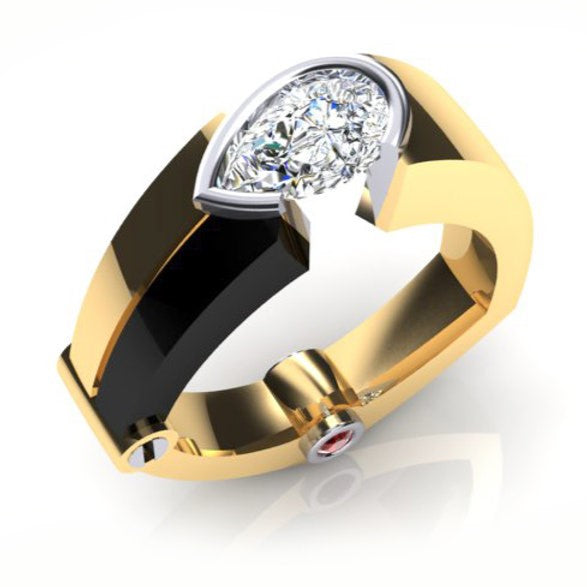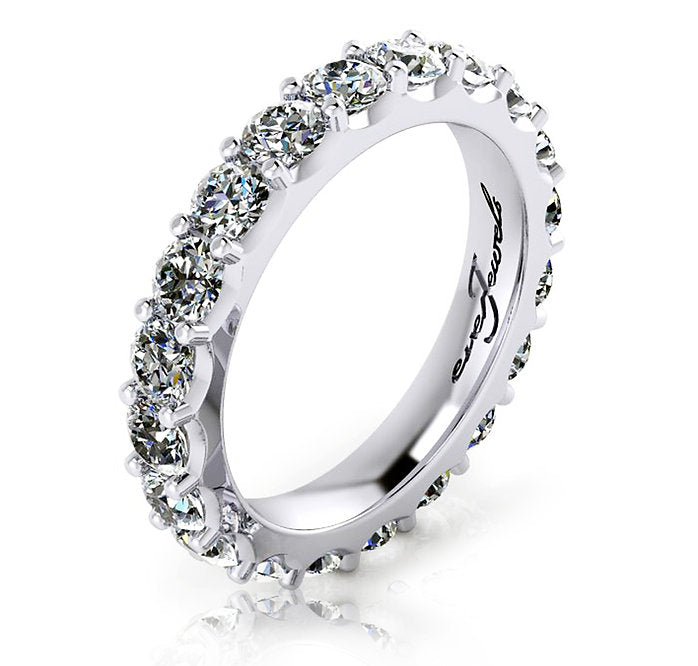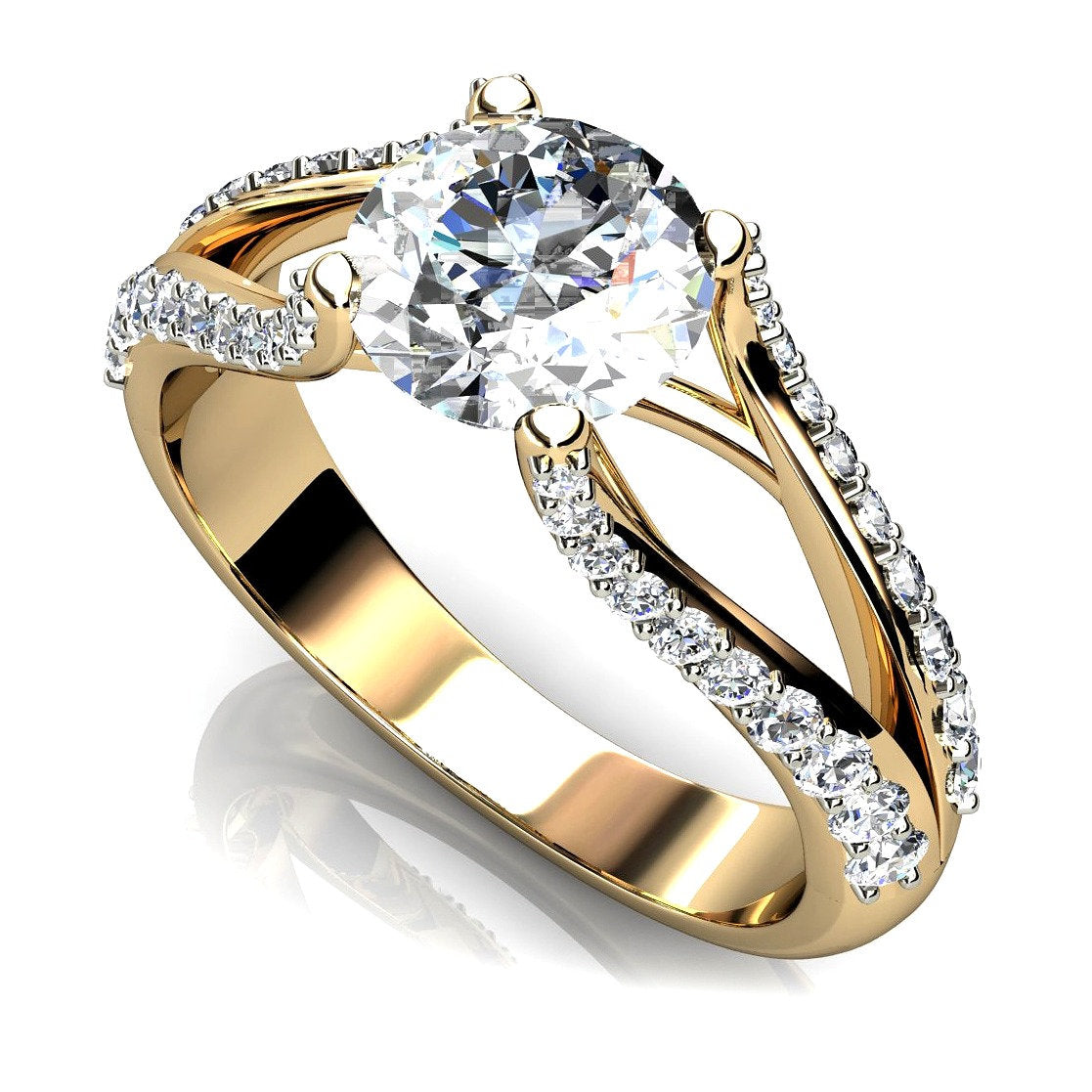At Forever Jewels Design Studio 8, we create jewellery that is inspired by life and its precious moments, with quality at the heart of everything we do. Every detail of our fine jewellery is carefully considered. The ultimate luxury is knowing how your piece has been created.

Diamonds are something extraordinary. Formed under immense pressure, hundreds of kilometres below the surface of the earth, a natural Diamond's one billion year journey is nothing short of miraculous. They were first discovered in India over two thousand years ago and have remained a symbol of beauty, love and abundance ever since. Strong, unique, precious, rare and beautiful - Diamonds are highly regarded for their magnificence and ability to reflect light in an extremely dazzling way. Created out of pure carbon, the carbon atoms within Diamonds are bonded very strongly, making them one of the hardest substances known to man. All American Swiss Diamonds half a carat and above are independently certified and are accompanied by a certificate detailing exact measurements, colour, clarity, carat weight, cut and features.
Our Diamonds are individually hand-selected according to the gemmologist quality criteria known as the 5 C's.
1. CUT In their natural state, Diamonds are quite dull. To bring out their inner lustre, each Diamond must be individually cut and polished to create facets. These facets reflect the light and unlock the stone's hidden brilliance. Of all the 5 C's, cut has the greatest effect on the beauty of a Diamond and is influenced by man's hand. The grading scale ranges from Excellent to Poor and at Forever Jewels Design Studio 8 we ensure that the world's most talented artisans cut our Diamonds to the highest precision. 2. COLOUR Diamonds are created when carbon crystallises deep underground. If any other elements are present during this process, they affect the Diamond's colour. Diamonds are considered more rare and valuable the closer they are to being colourless. The colour palette is varied and covers a wide spectrum. Most natural Diamonds have traces of a yellow or brown colour. Naturally coloured Diamonds, for example yellow or pink, are rare and are referred to as fancy. 3. CLARITY When a Diamond is formed, tiny particles of dust and other minerals can be trapped inside it. These are known as inclusions. Clarity refers to the internal purity of a Diamond - the fewer the inclusions, the more rare and valuable the stone. However, these inclusions make each Diamond unique - a fingerprint billions of years old that belongs to you alone. We provide a variety of options to maximise sparkle and your budget.
4. CARAT WEIGHT Carat refers to both size and weight of a Diamond. As a Diamond's weight increases, so does its value. Just as R1 is divided into 100 cents, a carat is divided into 100 points. For example, a 50-point Diamond weighs 0.50 carats. However, carat weight alone does not determine a Diamond's value. Two stones of equal weight can vary quite considerably in price because of quality differences. 5. CONFIDENCE We guarantee that every step of the process, from the sourcing of the rough to the cutting and polishing, is handled ethically by the best in the industry. We guarantee that all our Diamond pieces can be worn with the pride they deserve.
CUTS OF PRECIOUS STONES
ROUND The modern round brilliant is a true classic and the most popular Diamond cut. With a well-cut round Diamond, you're sure to get intense sparkle that will make your ring appear bigger. PRINCESS The most popular of the fancy Diamond shapes, the princess cut is contemporary and trendy with a square shape that offers intense sparkle. EMERALD Popular during the art-deco era of the 1950s to 1970s, the emerald cut exudes old-world glamour. With an elongated shape and rectangular facets, emerald-cuts have a slimming effect on the finger. CUSHION One of the oldest Diamond cuts, the cushion offers modern vintage style. It is sometimes referred to as the "pillow cut" because of its square shape with round edges that catch the light brilliantly. OVAL Oval-cut Diamonds have the brilliance of a round cut but with the added benefit of an elongated shape that gives a lengthening effect on the finger. The best of both worlds. PEAR A well-cut pear shaped Diamond should possess excellent symmetry. Like the oval, the pear comes in a variety of slim to wide cuts and has the ability to make the wearer's fingers appear longer and slimmer.
TYPES OF PRECIOUS STONES
MORGANITE Morganite is a soft peachy-pink colour and is revered for its beautiful clarity. From the same gemstone family as Emerald, it is durable and makes a stunning centre stone for a gemstone ring. With its pink hue, Morganite is believed to symbolise love, compassion, and joy. TANZANITE Found only at the foothills of Mount Kilimanjaro, Tanzanite varies from blue, to violet, or purple in colour. Its high vibrational energy invites protection and safety and allows for deep profound meditation. It also inspires compassion, love and happiness. GARNET January Birthstone Believed to protect the wearer, this vibrant gemstone has a rich red colour. It signifies health, vitality, and passion. Used to mark the second anniversary of marriage, it is a symbol of trust and eternal friendship. AQUAMARINE March Birthstone This gorgeous pale blue, transparent crystal is a member of the Beryl family. It's named after the mineral aquamarine, a gemstone mainly found in granite rocks. Aquamarine evokes feelings of calmness and level headedness. DIAMOND April Birthstone Renowned for their beauty, sparkling fire, durability, and rarity - Diamonds are the most-prized of all gemstones. They are said to clear emotional and mental pain, reduce fear and bring about new beginnings. AMETHYST February Birthstone Amethyst is a violet variety of Quartz. It ranges from pale lavender to deep violet and is said to symbolise wisdom, stability, and strength. It also encourages a clear head and quick wit. EMERALD May Birthstone Emerald is a brilliant deep green coloured, highly precious gemstone of the Beryl mineral family. One of the most reputed gemstones in Vedic astrology; it is worn for gaining foresight and good fortune. PEARL June Birthstone Lustre is what gives a natural or cultured Pearl its unique beauty. Often sought in white or cream, they come in a range of beautiful shades. Pearls symbolise wisdom, perseverance, and integrity. RUBY July Birthstone Rubies are vibrant red gemstones synonymous with vitality, passion, and seeking your heart's desire. Throughout history, they have been worn to guarantee health, wealth, wisdom, and success in love. PERIDOT August Birthstone Created from the fiery pits of volcanoes, Peridot is believed to be a gift from Mother Nature and is considered a symbol of the yearly renewal of the planet. Cherished for its healing powers, it promotes prosperity, fearlessness, and beauty. SAPPHIRE September Birthstone Known for its striking deep, ocean blue hue, this gemstone is also available in a number other colour varieties. Symbolising wisdom, serenity and focus, Sapphires have had an incredible history, drawing fame from royalty to playing a part in ancient legends. OPAL October Birthstone Opals are renowned for their radiant patterns of colour and the way in which they reflect light into a kaleidoscope of colour is truly unique. Symbolising hope, happiness and love, they also bring feelings of comfort. CITRINE November Birthstone The golden Citrine gemstone represents energy and abundance and is thought to brighten darkness and attract wealth. BLUE TOPAZ December Birthstone Topaz forms in various tones and saturations of yellow, gold, orange, red, blue, green, purple and brown, as well as colourless. Blue Topaz is a vivid sky-blue gemstone that symbolises spiritual connections and it brings solid, lasting energy, joy, generosity and abundance.
PRECIOUS METALS
There wouldn't be fine jewellery without precious metals in which to craft our beautiful pieces with. Our selection of metals ensures that our fine jewellery is affordable to all. We can assure you that our precious metals are responsibly sourced and authenticated, conforming to the international standards of purity.
PLATINUM Platinum is the most precious and valuable of all metals. Its natural white sheen makes it a beautiful setting for precious gemstones and its durability and scratch resistance makes it the perfect metal for jewellery such as wedding bands. At Forever Jewels Design Studio 8 we offer a limited range of Platinum pieces; however we do offer a bespoke service for creating something special for yourself.
GOLD Gold is one of the most precious metals and has been valued and revered for thousands of years. Its lustre and bright yellow sheen is instantly recognisable. However in its pure form, Gold is too soft to work with. To make it suitable for jewellery other metals (alloys) are added to pure Gold, making it more durable. This can result in not only a stronger metal but other colour varieties such as white and the ever so trendy rose.
STERLING SILVER Sterling silver is a timeless classic and has been a celebrated metal and form of currency since it was first discovered. Similar to Gold, Sterling Silver must have other metals added to ensure it is strong enough for jewellery. While Sterling Silver is best known for its brilliant polished shine, it can also come in a matte finish, allowing for a range of effects and designs.
MODERN METALS STAINLESS STEEL Stainless Steel is a scratch resistant, hypoallergenic and well-priced metal. Its silvery-white colour makes it ideal for men's rings, necklaces and bracelets. TITANIUM Titanium is silver-grey in colour and is the toughest metal known to man. It's hypoallergenic, lightweight and tarnish resistant, making it ideal for jewellery and every day wear. TUNGSTEN Tungsten is a luxurious, strong and heavyweight metal. It is more scratch resistant than any other precious metal. Its long-lasting shine and durability makes it ideal for jewellery. ZIRCONIUM Zirconium is a lustrous and silver coloured metal. It has a high resistance to scratching and tarnishing making it the ideal choice for fine jewellery, particularly men's pieces.
Taking care of your jewellery is therapeutic and a sign of self-care. Forever Jewels Design Studio 8 believes in keeping your jewellery looking as good as the day you owned it. Taking care of your jewellery is therapeutic and a sign of self-care.
By following a few simple tips you can keep your jewellery looking as beautiful as the day you bought it.
- Always remove your jewellery when washing your hands or applying perfume and makeup. Never spray perfume on top of jewellery, especially Pearls.
- Store your jewellery separately in a lined jewellery box or pouch to avoid scratching.
- Rhodium-plated jewellery must be re-plated annually.
- For cleaning your jewellery at home, make use of our jewellery cleaners and cloths available for purchase in-store.
For those occasions when your jewellery needs a little more care, speak to one of our experts and remember that Forever Jewels Design Studio 8 offers professional cleaning services for all jewellery.
HAND SANITISER AND YOUR JEWELLERY Forever Jewels Design Studio 8 believes in keeping your jewellery looking as good as the day you owned it. In light of the current Covid-19 pandemic, frequent hand-washing and sanitising isn't just for peace of mind, it's a necessity! The primary goal of hand sanitiser is to sterilize any germs, bacteria or toxic micro-organisms that can make you sick. But you could also be worried about what it's doing to your jewellery. We've broken it down for you.
What's the difference? Alcohol-based hand sanitiser Most hand sanitisers contain 60 - 95% alcohol and it is recommended to use a minimum of 60% alcohol to protect yourself against the Coronavirus. The ingredients include but are not limited to isopropyl or ethyl alcohol, water, glycerin and fragrance. Alcohol-based sanitisers are much safer for your jewellery.
Alcohol-free hand sanitiser The ingredients in alcohol-free sanitisers include but are not limited to antibacterial, triclosan, antiseptics and chloride cleaning agents. These chlorine-based compounds have the potential to release free chlorine when in contact with water; causing your jewellery to tarnish.
Soap Good old soap works just as well when it comes to protecting yourself. However, most soaps contain chemicals or oils that could possibly damage the surface of your jewellery. Solid soap particles can get under stone settings and stay there - this will cloud and dull your rings. It could also cause the coat of rhodium plating, found on white Gold rings, to get worn away.
What are the effects of this constant use of chemicals on your jewellery? Yellow Gold Hand sanitiser does not affect yellow Gold as much as some other metals. This is primarily because yellow Gold doesn't have a film or layer that can tarnish or wear down over time. However it can still become dull over time due to frequent use of sanitiser. Rose Gold Rose Gold is created by mixing yellow Gold alloys with copper to create its rosy red tint. Hand sanitiser can react to the copper elements causing your jewellery to tarnish and lose its shine over time. White Gold White Gold is plated in rhodium, which adds a protective layer to the Gold. It's normal for rhodium-plated jewellery to require re-plating over a period of time. However, hand sanitisers containing halogens could cause the plating to tarnish even faster. Platinum Platinum will never tarnish, as its surface is naturally white. It doesn't react with chemicals found in hand sanitisers, making it safe to wear. However, we recommend you still avoid contact and regularly clean your jewellery to avoid any residue that will dull the shine. Sterling Silver Be cautious of alcohol-free hand sanitisers when wearing Sterling Silver jewellery. The chlorine-based chemicals contain harsh compounds that will tarnish and strip away at the Silver, diminishing its shine and lustre. Diamonds Hand sanitiser won't damage diamonds, but it will leave a filmy residue on the stones dulling their sparkle and brilliance over time. Frequent hand washing will cause build-up between stones but it's nothing a quick soak can't fix. Pearls & Opals Pearls are soft and porous (absorbing water and liquid), and should not come into contact with sanitised skin until completely dry. We suggest waiting five minutes before wear. As with perfume and hairspray, the alcohol in sanitiser can change the surface of Pearls, creating a loss of lustre and change in colour. Just like Pearls, Opals are soft and porous and can easily be damaged by sanitiser. There will be visible cracks on the surface where the liquid dries out. We suggest waiting five minutes before wear. Gemstones Alcohol-based sanitisers could cause a filmy residue layer on the surface of gem stones, but this can easily be cleaned off with soapy water and an old toothbrush. Soap and alcohol-based sanitisers won't affect your Garnets, Rubies, Aquamarine or Sapphires, but chlorine-based (alcohol-free) sanitisers will. Emeralds are slightly less hardwearing, so you should avoid using both soap and sanitiser when wearing them. CLEANING YOUR JEWELLERY Your hands aren't the only things that need to stay clean, you jewellery needs to remain germ-free too! How to Sanitise Your Jewellery* * This excludes Pearls as they are more delicate.
- Remove jewellery item from packaging.
- Sanitise your hands.
- Add a few drops of dishwashing liquid to an old soft toothbrush.
- Lightly brush the surfaces of the jewellery item, creating a lather for 30 seconds.
- Rinse the piece thoroughly under warm water.
- Place the jewellery piece on a soft facial tissue.
- Allow to dry naturally in the sun.
How to Sanitise Your Pearls
- Remove jewellery item from packaging.
- Sanitise your hands.
- Add a few drops of dishwashing liquid to a cup of water.
- Take a soft cloth dip/ submerge it into the water.
- Ring the water out.
- Lightly wipe the surfaces of Pearls/Emeralds the jewellery item, with the damp cloth.
- Place the jewellery piece on a soft facial tissue.
- Allow to dry naturally in the sun.





0 comments